COIN: French Counter-Insurgency Aircraft, 1946-1965
Part I in a series
The 1950s, '60s, and '70s were the era of the "limited" war and the "low-intensity conflict."
All but a handful of the wars of the period were in essence small-unit actions dragged out over years.
Like the third-world conflicts and "policing actions" of an earlier generation, the struggles of the
limited-war era had their roots in foreign colonial policies or local ethnic and economic rivalries.
But they were also guided by ideological concerns to an extent that would have astonished a veteran
of the Northwest Frontier or the Riff Wars. For the first time, generals and politicians East and West
saw the grudges and jealousies of Belgian colons, Altiplano peasants, French pieds
noirs, Congolese Simbas, Indochinese intellectuals, British planters, Berber tribesmen, and
multinational mining cartels as parts of a single struggle. Every bombing in every Middle Eastern
bazaar, every strike at every African mine, and every overseer shot in South America was suddenly a
crucial battle in the Cold War, the apocalyptic death-struggle of East and West, capital and labor.
This peculiar outlook colored every aspect of late 20th-century strategy and tactics and gave rise
to a new understanding of the purpose, design, and use of aircraft in combat. No country contributed
more to this development than did France.
France came out of World War 2 determined to recover and exploit an extensive prewar colonial empire.
Yet she faced serious moral and material difficulties. She had neither defended her colonies against Axis
invasion nor liberated them from subsequent occupation. She could claim her colonies neither by moral
right nor by right of arms. In the eyes of her former subjects and her most important allies, she was
a two-time loser. She had capitulated early to Germany and Japan and, by helping them little and breaking
with them late, had shared in their final defeat. The heavily publicized but minor assistance
that the Resistance and the Free French rendered the Allies during the liberation of France had done
little to rebuild French prestige by 1945, and her place as a great power had more to do with emerging
Cold War politics and the future makeup of the United Nations Security Council than it did with France's
actual stature in the world. The body politic at home was sharply divided. The economy was still largely
in ruins, and the military was noticeably weak. Manpower and finance were in desperately short supply.
Conscription for overseas service was politically impossible, and the bulk of the modern arms—American
Lend-Lease equipment—had to be returned to the US or used only in Europe. The undermanned Colonial forces
had to make do with a hodgepodge of pre-war French relics, British surplus, American salvage, and German
arms manufactured in French factories during the war. Of the wartime allies, only the rival colonial
powers—Britain, Belgium, and the Netherlands—could be counted sympathetic to a policy of forced
recolonization. Militarily, they were in as bad a position as France. America was inclined to
back the national aspirations of indigenous leaders like Ho Chi Minh, who had fought the Japanese
during the war, while Soviet Russia turned increasingly from its near exclusive focus on the industrial
proletariat of Europe and America to the nationalist, third-world peasantry that was sweeping Mao into
power in pre-capitalist, pre-industrial China.
France's immediate, postwar colonial policy did little to reestablish French prestige or win her
friends in the international community. In French North Africa, decorated tirailleurs algériens
—among them the future revolutionary, Ben Bella—who had fought alongside American GIs and British Tommies
saw European-born collaborators haughtily
reclaim the monopoly on privilege and power guaranteed under the prewar status quo, while advancement and
influence in the army went to the hoardes of fugitive SS and Wehrmacht men that France now welcomed
into its reconstituted Foreign Legion. In Indochina, returning French authorities rearmed as yet
undemobilized Japanese troops to oversee the disarming of Viet Minh guerillas who had fought for
the Allies. This ill-treatment of fellow victors by the defeated embarrassed the United States and
frightened the Soviet Union, cutting France off from its most obvious source of aid while guaranteeing
an equally ready source of help for her enemies.
As so often in French military history, France's response to this dilemma was theoretical rather than
practical. No serious attempt to understand either the potential value of the colonies to France under
the new economic conditions prevailing in the world or the grievances of the subject peoples seems to have
been made. Limited, practical reforms and early, inexpensive disengagement seem to have been overlooked or
tried only half-heartedly. Nor was any great effort expended on strengthening the armed forces for the
struggles that national policy would soon precipitate. Instead, the staff colleges were put to work
perfecting the latest in a long series of precedent-setting, but ultimately vain theories of war.
The task was a difficult one. Given the crippling limitations that faced France in the post-war third
world, the French theorists had to think up a winning strategy that did not put a premium on the familiar
elements of military power—money, numbers, and firepower—all of which France lacked. Nor could the new
strategy count on the traditional stay of a militarily weak party, moral solidarity with the populace,
in the manner of the Napoleoonic-era Spanish guerillas or the wartime partisans of Eastern Europe. In
the battles to come, French forces would fight with the people against them, overseas and perhaps at
home as well.
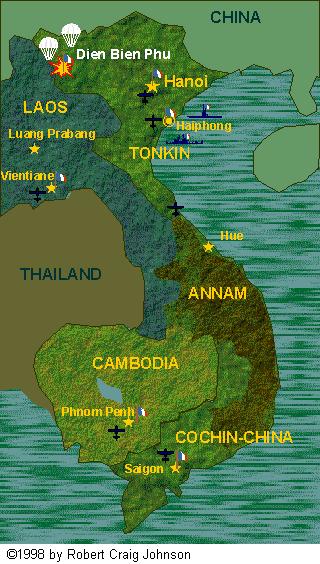 All this staff-level cerebration
resulted in a technical and political tour de force, the counter-insurgency or
limited-war doctrine that would in large part shape international relations for the next four
decades. Like many earlier French efforts, it was self-consciously revolutionary, extreme, idealistic,
and short on the gritty details that often make or break real campaigns. While the French theorists
conceived a whole range of practical, tactical measures, some of which form the main subject of
this article, they did not place much hope in the mechanics of a material struggle that they all
but conceded to the Asian and African hoardes. Instead, they recast war as an ideological, moral
struggle, a crusade that would be won by the spiritually stronger society. When they tried to define
the best way of using France's limited resources in the kind of war she now had to fight, they stressed
the esprit de corps of small, élite units, the resourcefulness and self-sacrifice of the
wholly committed individual, the professionalism and mystical, sacred honor of the army, and the
supposedly world-historical, civilizing mission of France. Combined operations, mobility,
intelligence, and psycho-political warfare would be important. But these tactical expedients were
only ways of winning time. While France's paladins kept the enemy at bay, the real battle—the battle for
hearts and minds—would be fought elsewhere, at home and, above all, in the treasury of the post-war
West, the United States.
All this staff-level cerebration
resulted in a technical and political tour de force, the counter-insurgency or
limited-war doctrine that would in large part shape international relations for the next four
decades. Like many earlier French efforts, it was self-consciously revolutionary, extreme, idealistic,
and short on the gritty details that often make or break real campaigns. While the French theorists
conceived a whole range of practical, tactical measures, some of which form the main subject of
this article, they did not place much hope in the mechanics of a material struggle that they all
but conceded to the Asian and African hoardes. Instead, they recast war as an ideological, moral
struggle, a crusade that would be won by the spiritually stronger society. When they tried to define
the best way of using France's limited resources in the kind of war she now had to fight, they stressed
the esprit de corps of small, élite units, the resourcefulness and self-sacrifice of the
wholly committed individual, the professionalism and mystical, sacred honor of the army, and the
supposedly world-historical, civilizing mission of France. Combined operations, mobility,
intelligence, and psycho-political warfare would be important. But these tactical expedients were
only ways of winning time. While France's paladins kept the enemy at bay, the real battle—the battle for
hearts and minds—would be fought elsewhere, at home and, above all, in the treasury of the post-war
West, the United States.
France's new military doctrine recast France's colonial problems as key battles in the larger
struggle with communism, the struggle that preoccupied the United States during the postwar years.
French staff officers argued that the US and Britain were feverishly preparing for threats that
would never emerge and ignoring the real, present danger. The unprecedented power of nuclear weapons
made armored assaults across the North-German plain or nuclear bomber attacks on North America suicidal
propositions. The Soviets would never dare to mount all-out, open attacks on the West. Instead, the
French insisted, Russia would concentrate on the vulnerable African, Near-Eastern, and Asian fringes
of Western society, the sources of the raw materials, cheap labor, and closed markets that Western
capitalism supposedly required. Seen in context, third-world nationalism and anticolonialism were
thus not simply products of the inequities of colonial administration, as Americans generally assumed
in the 1940s. They were fronts for covert Soviet aggression. As Washington blindly watched the
European horizon for hordes of tanks and missiles, third-world agitators, trade unionists, and
guerillas were quietly sapping the foundations of the Western economy and way of life. The communist
assault that Washington feared was, in short, already underway, and the French were in the thick of it,
fighting the good fight so that Americans could sleep soundly.
Measured by its success in converting the United States to France's vision of international
relations in the nuclear age, limited-war theory was amazingly successful. The support for self-
determination that drove American policy during the Roosevelt and early Truman years
gave way, by the Eisenhower administration, to whole-hearted if secret support for France's colonial
aims and a marked readiness to adopt her methods elsewhere in the third world. By 1952 or so, the
policies that would lead America into Vietnam and a score of lesser involvements in Africa and South
America were already well-established in Washington.
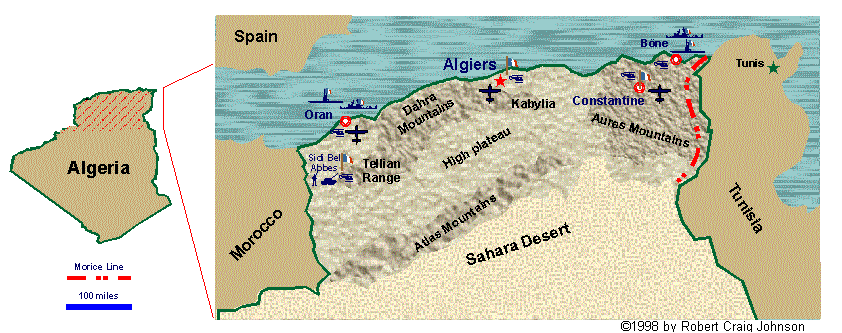
Initially, success proved more illusive in the field. French planners counted on achieving localized
superiority in numbers and firepower to offset the superior human and material resources their
opponents could muster in the overall theater of operations. Small, highly motivated bands of commandos
would do the work of the much larger conventional armies that France lacked. This strategem presumed a
high degree of mobility that was, unfortunately, all but unobtainable under the conditions prevailing
in the colonies. In Indochina, trucks bogged down as soon as they strayed from a few easily blocked,
ambush-prone roads. In North Africa, they got stuck in desert sand or broke down on rocky, mountain
tracks. Armored vehicles proved incapable of providing adequate covering fire. Aging M-8 armored cars
bogged down almost as badly as the trucks. In Indochina, Stuart and Chaffee light tanks could not ford
the myriad waterways or use more than a handful of the bridges. In Algeria, tanks proved too slow, too
short on range, and too noisy for hunting small, dispersed bands. They gave away their presence before
they could close with the enemy. Amphibious vehicles, particularly the little, jeep-sized Weasels,
could operate anywhere in Indochina. But, with little or no armor and limited payload, they could
neither survive nor fight. The élite commandos were frequently confined to a relative handful of
garrison towns, where their special skills were useless and their vaunted morale vulnerable to
boredom and frustration.
Air power was thus crucial to counterinsurgency strategy. When airplanes and helicopters replaced
vulnerable, ambush-prone road convoys, the pace of operations and, with it, the likelihood of success
increased enormously. 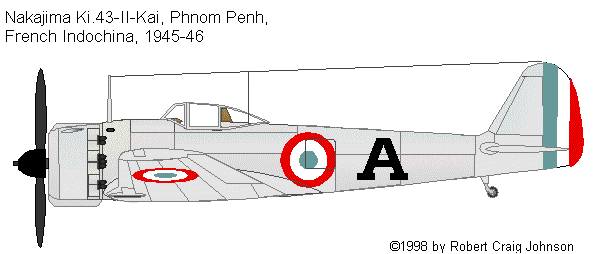 Guerillas could not concentrate rapidly enough to overrun outposts before reinforcements arrived. Nor
could they easily disperse or evade pursuit. Since route security was no longer necessary, far fewer
troops were necessary. Major operations could be mounted by relative handfuls of professional light
infantry—Foreign Legionaires, paras and marine commandos. It was even hoped that, in the absence
of aerial opposition, modern combat aircraft could give the airborne force the firepower that light
infantry had lacked in the past. With napalm, rockets, fragmentation bombs, and machine guns, a few
pilots could, perhaps, do most of the killing from the safety of the air, before the infantry arrived.
Survivors could then be kept constantly on the run and never allowed to rest or regroup. Most
importantly of all, air power could greatly reduce the political vulnerability of colonial operations.
By reducing the need for large numbers of French troops, air strikes minimized casualties and
obviated much of the need for unpopular, large-scale conscription.
Guerillas could not concentrate rapidly enough to overrun outposts before reinforcements arrived. Nor
could they easily disperse or evade pursuit. Since route security was no longer necessary, far fewer
troops were necessary. Major operations could be mounted by relative handfuls of professional light
infantry—Foreign Legionaires, paras and marine commandos. It was even hoped that, in the absence
of aerial opposition, modern combat aircraft could give the airborne force the firepower that light
infantry had lacked in the past. With napalm, rockets, fragmentation bombs, and machine guns, a few
pilots could, perhaps, do most of the killing from the safety of the air, before the infantry arrived.
Survivors could then be kept constantly on the run and never allowed to rest or regroup. Most
importantly of all, air power could greatly reduce the political vulnerability of colonial operations.
By reducing the need for large numbers of French troops, air strikes minimized casualties and
obviated much of the need for unpopular, large-scale conscription.
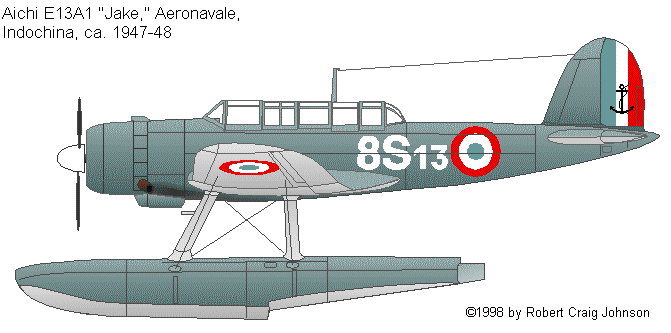
When these new ideas were first tested, in Indochina in 1945, they were not very successful.
French forces had too few aircraft to provide the level of support the army needed, and the available
airplanes were worn, out of production, and ill-suited to their new roles. The United States refused
to allow its European allies to use US-supplied equipment against their erstwhile colonial subjects,
so the bulk of France's air force—P-47Ds based in Europe—could not be sent to Indochina. When nationalist
Viet Minh insurgents resisted the reimposition of French rule in their homeland, Armée de
l'Air units were at first forced to use abandoned Japanese aircraft, including Nakajima Ki.43
Hayabusa fighters and Aichi E13A-1 seaplanes. These were supplemented by the German wartime types
tht were built in France during the occupation. The Amiot AAC.1 Toucan (Junkers Ju-52) was used for
transport and paratrooping duties, and the Morane-Saulnier Criquet (Fieseler Fi-156 Storch)
performed communications, observation, forward air control, and convoy escort missions. The British
transferred 246 Squadron's Spitfire Mk. VIIIs in 1946, when the squadron left Tan Son Nhut to return
to England, and these were supplemented by Spitfire LF.IXc and Mosquito FB.VI fighter-bombers hurriedly
ferried in from Europe. These airplanes performed poorly in the colonial close-support role. The Spitfire
had too short a range and too small a warload. Both types proved too fragile for long service in the
tropics. The Spitfire's narrow-track undercarriages proved ill-suited to the short, uneven, PSP (Pierced
Steel-Plank) runways common in Indochina. Ground-loops and undercarriage failure were common. The Mosquito
had a robust undercarriage and a large disposable load, but, as the British and the Australians had
already discovered during the war, its wooden structure suffered severely from heat, damp, and insects.
Availability was generally low.
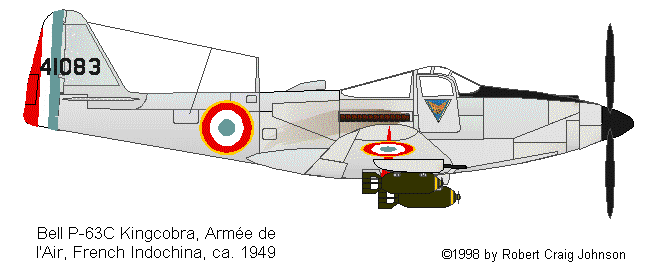 In 1948 and '49, the rapid collapse of the Kuomintang regime in China and the apparently cordial
relations between the Viet Minh and Mao's Communist party caused the US to relent and allow
France to deploy some of its American equipment in Southeast Asia. Fifty Bell P-63C Kingcobras were
hurriedly despatched from Europe. They proved well suited to the climate and the prevailing type of
operations. Their range was better than the Spitfires, and were highly resistant to the ever increasing
volume of groundfire that French pilots faced over Viet Minh-dominated areas. The lifting of the
ban on US warplanes also let the French Aéronavale take a more active role in the conflict. The
light carrier Arromanches took up station in the gulf of Tonkin and used its SB2C Helldivers,
F6F-5 Hellcats, and, eventually, F4U-7 Corsairs to good effect during the remainder of the campaign.
Douglas SBD-5 Dauntless dive bombers and Consolidated PB4Y-2 Privateers operated from shore bases. The
Long time on station and heavy bombloads made the Privateers particularly useful. They were often pressed
into service as flareships during night assaults on French positions.
In 1948 and '49, the rapid collapse of the Kuomintang regime in China and the apparently cordial
relations between the Viet Minh and Mao's Communist party caused the US to relent and allow
France to deploy some of its American equipment in Southeast Asia. Fifty Bell P-63C Kingcobras were
hurriedly despatched from Europe. They proved well suited to the climate and the prevailing type of
operations. Their range was better than the Spitfires, and were highly resistant to the ever increasing
volume of groundfire that French pilots faced over Viet Minh-dominated areas. The lifting of the
ban on US warplanes also let the French Aéronavale take a more active role in the conflict. The
light carrier Arromanches took up station in the gulf of Tonkin and used its SB2C Helldivers,
F6F-5 Hellcats, and, eventually, F4U-7 Corsairs to good effect during the remainder of the campaign.
Douglas SBD-5 Dauntless dive bombers and Consolidated PB4Y-2 Privateers operated from shore bases. The
Long time on station and heavy bombloads made the Privateers particularly useful. They were often pressed
into service as flareships during night assaults on French positions.
WW2-vintage aircraft were getting decidedly old and tired by 1949, however. None were particularly fresh
when they arrived in Asia, since most had flown operations during the war. Months of operating from PSP,
in hot, dusty conditions, and with far heavier loads than their designers had intended
took their toll on these veteran airplanes. Many had engines that were designed for
high output and good economy at high altitudes. Low-level operations no doubt took a toll in the
form of increased wear, higher operating temperatures, and heavy fouling of engine components.
Serviceability was poor by the end of the '40s, and spares were getting hard to find. Many of
the French airplanes were types that were no longer in active, US service (P-63, SBD, F6F) and
thus no longer supported by the normal American supply channels. Others—like
the Toucan—had never been wholly satisfactory and were now totally obsolete.
The Korean War was thus a lucky break for France. While the immediate needs of the US services at
first precluded delivery of aircraft the French especially wanted—notably B-26 Invaders, F-51
Mustangs, and additional Corsairs—Russian and Chinese involvement seemed to confirm France's
interpretation of third-world nationalism. A global communist conspiracy seemed more plausible in
Washington when Chinese soldiers were crowding round the Pusan perimeter.
In 1950, after considering and rejecting a large-scale supply of B-25s and F-47s—replacement parts
could no longer be had in the quantities required for operatinal use—US authorities decided to
supply France with a single squadron of B-26 Invaders—25 aircraft—as an interim measure. The French would
also be given priority access to all materiel not immediately required by frontline UN units.
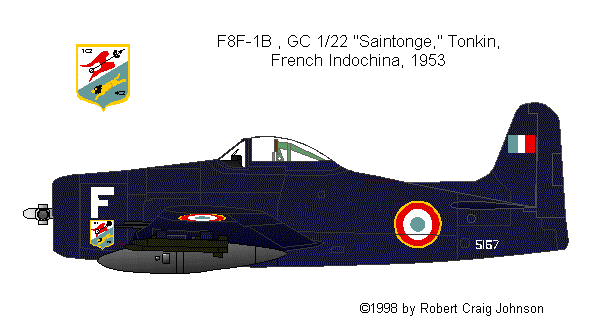 Ex-USAF C-47 transports soon replaced the inadequate Toucan in the transport role. The
Aéronavale received additional Hellcats in lieu of Corsairs (though the specially built F4U-7 and
some surplus AU-1s were supplied later), while the Armée de l'Air got the Grumman F8F-1 Bearcat,
a type relegated to Navy Reserve and National Guard units in the US. A further five RB-26C reconnaissance
airplanes and 16 B-26C bombers arrived in 1952. Armed with napalm, 500-lb demolition bombs, M1A1
fragmentation clusters, 5-in HVAR rockets, and .50-cal machineguns (up to fourteen on the B-26s, most
of which had the late-war, 6-gun wings and both turrets) or 20-mm cannon (many F8Fs and F6Fs and all
the Corsairs) the new strike aircraft were reasonably effective. But they were still too few, and the
single-engined types lacked the range and endurance that were increasingly necessary now that Viet Minh
were now concentrated in Laos and along the Chinese border (the mainstay of the fighter-bomber force,
the F8F, had, after all, been designed as a short-range, high-performance interceptor of Kamikazes).
Ex-USAF C-47 transports soon replaced the inadequate Toucan in the transport role. The
Aéronavale received additional Hellcats in lieu of Corsairs (though the specially built F4U-7 and
some surplus AU-1s were supplied later), while the Armée de l'Air got the Grumman F8F-1 Bearcat,
a type relegated to Navy Reserve and National Guard units in the US. A further five RB-26C reconnaissance
airplanes and 16 B-26C bombers arrived in 1952. Armed with napalm, 500-lb demolition bombs, M1A1
fragmentation clusters, 5-in HVAR rockets, and .50-cal machineguns (up to fourteen on the B-26s, most
of which had the late-war, 6-gun wings and both turrets) or 20-mm cannon (many F8Fs and F6Fs and all
the Corsairs) the new strike aircraft were reasonably effective. But they were still too few, and the
single-engined types lacked the range and endurance that were increasingly necessary now that Viet Minh
were now concentrated in Laos and along the Chinese border (the mainstay of the fighter-bomber force,
the F8F, had, after all, been designed as a short-range, high-performance interceptor of Kamikazes).
With the end of the Korean War in early 1954, the United States greatly stepped up its involvement
in French Indochina. But, to maintain the "plausible deniability" that rendered so many poorly
thought-out Southeast-Asian schemes palatable to American administrations, the intervention was
placed in the hands of the CIA and its proprietary airline, Air America. To meet France's need for
airlift capacity and long-range, high-endurance strike aircraft, USAF C-119 transports and B-26s
were flown from Korea to Taiwan and the Philippines for overhaul. They were "sanitized" (rendered
anonymous and hopefully untraceable), then transferred to the CIA for use in Indochina. USAF volunteers
were "sheep-dipped"—stripped of the most obvious signs of their ongoing service connections—and
transferred to Air America as C-119 pilots and loadmasters. 200 active-duty USAF B-26 mechanics were
quietly seconded to the Armée de l'Air to maintain the CIA's bomber force, on the condition
that they serve only in secure areas, where they could not be captured or spotted by reporters.
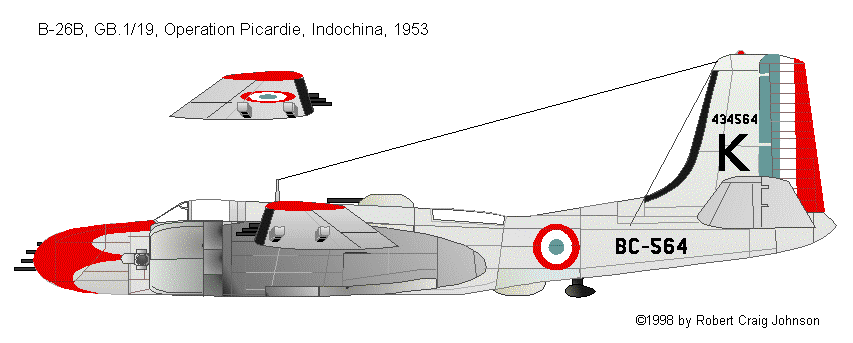
This infusion of airpower was, however, too little and too late for the French in Indochina. They
never achieved the level of mobility and the firepower that their new tactical doctrines required.
Nor had they put the necessary effort into civil action and political operations. Air transport and
strike forces were manifestly inadequate, despite US involvement. When the French mounted their last
and greatest exercise in counterinsurgency warfare in Indochina, the battle of Dien Bien Phu, it was
a disaster. The plan called for a modest garrison of élite paras and Legionaires
to parachute into a remote valley deep in enemy territory. Aerial resupply and aerial firepower
would turn this seemingly exposed and isolated position into an impregnable fortress. Viet Minh troops
would rush out into the open plane, intent on swallowing up the deceptively vulnerable French position,
and air strikes would annihilate them, winning the war more or less at a single stroke. Unfortunately
for the paras, French and American planners had seriously overestimated their ability to resupply
and support the force deployed from the air. C-47s and C-119s could not mount enough sorties or carry
enough food and ammunition in the face of bad weather and heavy enemy fire. At first, only B-26s and
PB4Y-2 Privateers could provide any useful coverage of Dien Bien Phu. Bearcats could manage only a
single strafing run over the target areas and, even then, had to carry so much extra fuel for the
round trip that they could carry no bombs or rockets. By building an airstrip inside the perimeter
at Dien Bien Phu, the French were able to base a half-dozen Bearcats at Dien Bien Phu. The strip was
long enough for C-47s (but not C-119s), so the French, were for a time, able to supply bombs, ammunition,
and food and could evacuate some of the wounded. They even flew in a bulldozer and a couple of
dismantled Chaffee tanks. But the flying artillery that the plan counted on was no match for the
75- and 105-mm howitzers that Gen. Giap's soldiers had laboriously hauled cross country to Dien Bien Phu.
Heavy shelling quickly made the airstrip unusable, drastically reducing the flow of supplies into the base.
The Bearcats could no longer operate from the valley, sharply reducing the volume and timeliness of
air support. Giap's heavy automatic weapons—12.7-mm machine guns and 37-mm antiaircraft guns emplaced
on the heights above the valley—took a heavy toll of the strike aircraft and transports. Much of
available strike capacity had to be dedicated to flak suppression, just so the C-119s could drop
desperately needed ammunition and plasma into a rapidly shrinking French perimeter. When Dien Bien Phu
finally collapsed, the French war effort in Southeast Asia collapsed with it, and colonial rule came to
an end.
As the last, ragged defenders of Dien Bien Phu were being overrun, in May 1954, US President Eisenhower
came close to repudiating France's subtle, limited-war strategy in the bluntest way possible—a
nuclear strike on Viet Minh positions using unmarked USAF B-29 bombers. Only the difficulty of
identifying a worthwhile target and the rapidity of the final collapse prevented him. The idea of
low-intensity conflict seemed to have failed miserably, so much so that only massive escalation
seemed capable of containing the Red menace. Half a world away, however, French officers were already
applying the lessons of Indochina to a new insurgency on France's doorstep, in Algeria.
Algeria presented France with a set of tactical and political problems as different as the North
African terrain differed from that of Indochina. Politically, Algeria was an integral part of the
French Republic rather than a colony. Its native Berber and Arab people were technically French
citizens. But discrimination was rife, and the European immigrants, the pieds noires, had a
stranglehold on local government, owned most of the arable land, and controlled the police. When Arabs
and Berbers were belatedly allowed to vote for half of a constituent, provincial assembly in 1948 and
1951, blatant fraud gave the pieds noire candidates a sweeping victory. The resulting anti-European
riots were savagely repressed, at a cost of thousands of lives.
When long-simmering resentments erupted in open rebellion by the Front pour la Libération
Nationale (FLN) in 1954, the Armée de l'Air deployed its best and latest equipment in
defense of French Algeria: the new SNCASO SE.535 Mistral jets
(license-built DeHavilland Vampires). 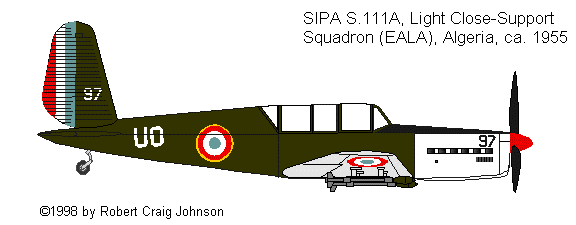 But they proved woefully ineffective. They lacked endurance and proved hard to maintain in the sand and
dust of North Africa. Worse, they were too fast. It was all but impossible to spot and attack small
groups of guerillas from a fast jet. The Republic F-47D Thunderbolts of the advanced training units
proved more effective, but they were old and parts were all but impossible to obtain. Since there were
no propellor-driven replacement fighter-bombers available in 1955, local French commanders
began to arm light transports and trainers. Dassault MD.311 Flamants, Morane-Saulnier MS.500s, and
the SIPA S.111s and 211s were fitted with machine guns and 37-mm rockets. These airplanes were formed
into Escadrilles d'Aviation Legère d'Appui (EALA)—Light Tactical Aviation Squadrons—and used to
good effect. With an observer spotting targets from the rear seat, such an aircraft was roughly twice
as likely to spot a target as a conventional fighter-bomber and, given the relative unsophistication
of the adversary, its light armament (no more than four rockets or two machine guns for the
SIPAs and MS.500s) was not too great a handicap.
But they proved woefully ineffective. They lacked endurance and proved hard to maintain in the sand and
dust of North Africa. Worse, they were too fast. It was all but impossible to spot and attack small
groups of guerillas from a fast jet. The Republic F-47D Thunderbolts of the advanced training units
proved more effective, but they were old and parts were all but impossible to obtain. Since there were
no propellor-driven replacement fighter-bombers available in 1955, local French commanders
began to arm light transports and trainers. Dassault MD.311 Flamants, Morane-Saulnier MS.500s, and
the SIPA S.111s and 211s were fitted with machine guns and 37-mm rockets. These airplanes were formed
into Escadrilles d'Aviation Legère d'Appui (EALA)—Light Tactical Aviation Squadrons—and used to
good effect. With an observer spotting targets from the rear seat, such an aircraft was roughly twice
as likely to spot a target as a conventional fighter-bomber and, given the relative unsophistication
of the adversary, its light armament (no more than four rockets or two machine guns for the
SIPAs and MS.500s) was not too great a handicap.
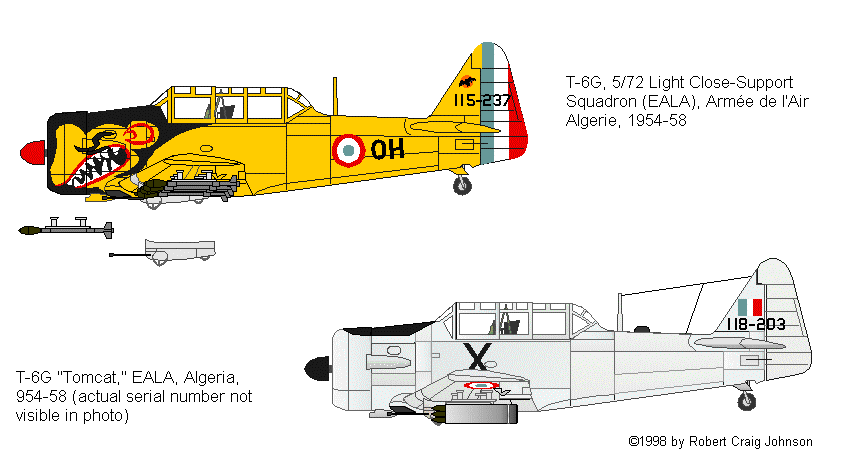
The French trainers—particularly the SIPAs, French-made Arado 396s powered by French-made Argus As 410
engines—were, however, too light and too fragile to make efficent warplanes in the long term. As the war
dragged on and as the sophistication of the enemy increased, the French had to look for more
powerful substitutes. Happily, one of the hastily adapted trainers had proved well-suited to its new tasks.
Surplus, American and British T-6 Texans, SNJs, and Harvards turned out to be rugged, easily maintained,
and efficient attack aircraft when equipped with a pair of pods housing twin, 7.5-mm machine guns and
racks for fragmentation bombs, rockets, and napalm canisters. The Tomcats, as they bevcame known, stood
up well in the face of ground fire, had a good endurance, and were still available in quantity.
Four escadrilles were formed on the T-6 in 1955. By 1958, the total had risen to more than 30.
(Note: the French were perhaps the first to use the T6 in this way, since operations preceded the USAF
FT-6 program by some years. Many of the French airplanes were subsequently passed on to third-world
clients, including Katanga.)
Given the relative success of the B-26 Invader in Indochina, the French were anxious to obtain the
aircraft for use in Algeria (the Indochina aircraft were CIA-owned and, at the conclusion of
hostilities, were returned to secret Agency depots on Taiwan and at Clark Field in the Philippines).
In 1956, France requested B-26s under MDAP, the US Mutual Defense Aid Program. The aircraft were ostensibly
stopgap equipment for France's European bomber squadrons, pending availability of the Vautour
twin-jet bomber. They were overhauled by Fleetways in California and Fairey in the UK, then ferried to
France. The aircraft equipped two groups, GB.1/91 Gascogne and GB.2/91 Guyenne, both
based at Oran. A photoreconaissance squadron, ERP.1/32 Armagnac, received RB-26Cs.
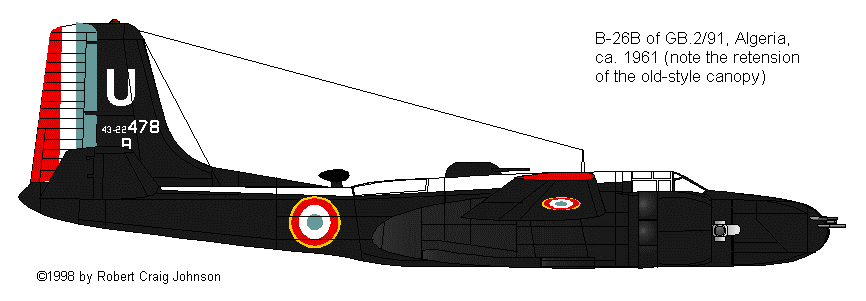
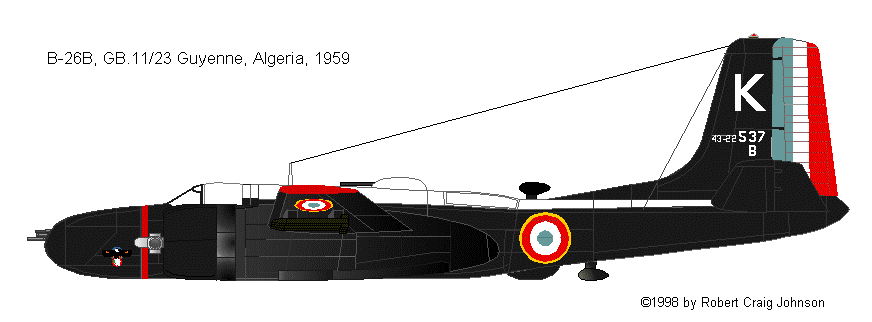
While, in Indochina, B-26s were flown both in bare metal and black, with USAF serials, and with
French cockades in the four positions used by the USAF, French B-26s in Algeria were without
exception black and marked in French fashion (French serials and six-position national insignia).
The top half of the fuselage was usually painted gloss white in order to reduce the heat inside the
fuselage. While both 6- and 8-gun B-26Bs were common, most B-26s lacked the the six, built-in wing guns
of the late-model aircraft. Consequently, both B-26Bs and B-26Cs carried two or four of the early type
twin gun pods under the wings. Turrets were now generally unarmed and were often removed altogether.
Most(but not all) received the late-model blown canopy during refurbishment.
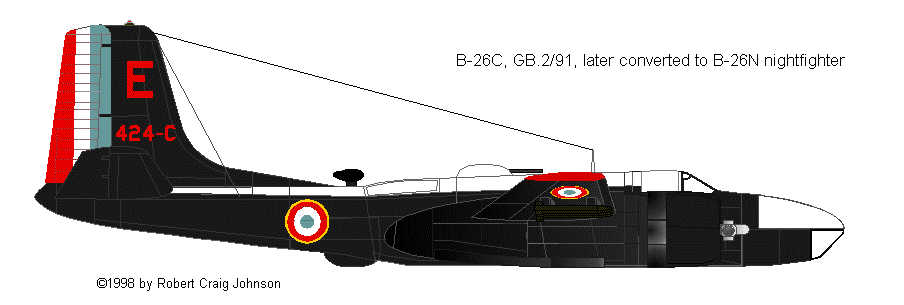
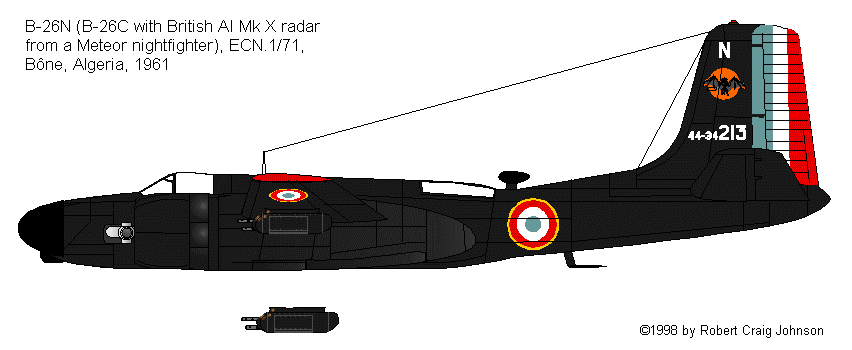
By 1957, newly independent Tunisia had become a major source of supply for the FLN. The French
responded with the Morice Line, an elaborate system of sensors, electrified border fences, mine fields,
and forts stretching the length of Algeria's eastern border. When an incursion was discovered, either by
sensors or reconnaissance aircraft, B-26s and Aéronavale Privateers, Lancasters, and, later,
Lockheed P2V Neptunes would attack the intruders continuously until helicopter-borne paras
could arrive on the scene. The border fortifications worked reasonably well, but French authorities
were aware that they could be easily breached by light aircraft. When air-defense radars at the Bône
naval base seemed to show multiple tracks at low altitudes and low air speeds over the line, two
radar-equipped MD-315 light transports were hastily despatched for night fighting duty. Predictably,
they proved too slow and too short on endurance. The French then decided that they needed a special
colonial night fighter. A small number of Invaders were thus converted and given the designation B-26N.
The aircraft had British AI Mk.X radar (from French Meteor NF.11s), and an armament of two underwing
gun pods, each housing two .50-cal machine guns, and two MATRA 122 pods for SNEB air-to-air rockets.
By 1961, the B-26N fighters had intercepted 38 light aircraft and helicopters, downing nine.
By 1958, France's fleet of T-6 Tomcats was seriously in need of replacement. The once plentiful
supply of spare parts and surplus engines had begun to dry up, and most of the airframes were worn
out. Once again, the French search for a replacement anticipated US efforts of a few years later:
France chose the T-28. At the time, only low-powered T-28A aircraft were available (from US surplus
stocks at the Davis-Monthan AFB bone yard), because all new T-28Bs were going to the Navy.
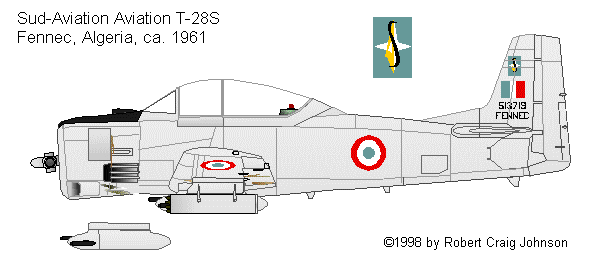 However, a
private, California firm, Pacific Airmotive, was then offering a more powerful, civilianized T-28A
called the Nomad. In place of the 800-hp Wright R-1300 of the T-28A, the Nomad mounted a 1425-hp
Wright R1820-76A Cyclone salvaged from B-17G stocks. Performance was excellent, but there were few
civilian takers. France accordingly contracted with Pacific Airmotive for the design of a Nomad
variant fitted with armorplate, reinforced wings, and increased cockpit ventilation: the
T-28S Fennec ("Desert Fox"). Under the agreement, the California firm supplied design drawings,
engines, and airframes for shipment to France, where Sud-Aviation would perform the conversion and
install French equipment, armament, and sand filters. Fennecs were strenghtened to take four
underwing weapons pylons. The two inner pylons usually carried French-designed pods for twin
.50-cal (12.7-mm) machine guns. The outer pylons could carry shortened 440-lb bombs, 7- or 36-round
pods of 37- or 68-mm rockets, napalm, or single 105- or 120-mm rockets. By 1961, over 100 Fennecs were
operating with four EALAs in Algeria, with 50 more in reserve or final assembly. But their time in
service was brief.
However, a
private, California firm, Pacific Airmotive, was then offering a more powerful, civilianized T-28A
called the Nomad. In place of the 800-hp Wright R-1300 of the T-28A, the Nomad mounted a 1425-hp
Wright R1820-76A Cyclone salvaged from B-17G stocks. Performance was excellent, but there were few
civilian takers. France accordingly contracted with Pacific Airmotive for the design of a Nomad
variant fitted with armorplate, reinforced wings, and increased cockpit ventilation: the
T-28S Fennec ("Desert Fox"). Under the agreement, the California firm supplied design drawings,
engines, and airframes for shipment to France, where Sud-Aviation would perform the conversion and
install French equipment, armament, and sand filters. Fennecs were strenghtened to take four
underwing weapons pylons. The two inner pylons usually carried French-designed pods for twin
.50-cal (12.7-mm) machine guns. The outer pylons could carry shortened 440-lb bombs, 7- or 36-round
pods of 37- or 68-mm rockets, napalm, or single 105- or 120-mm rockets. By 1961, over 100 Fennecs were
operating with four EALAs in Algeria, with 50 more in reserve or final assembly. But their time in
service was brief.
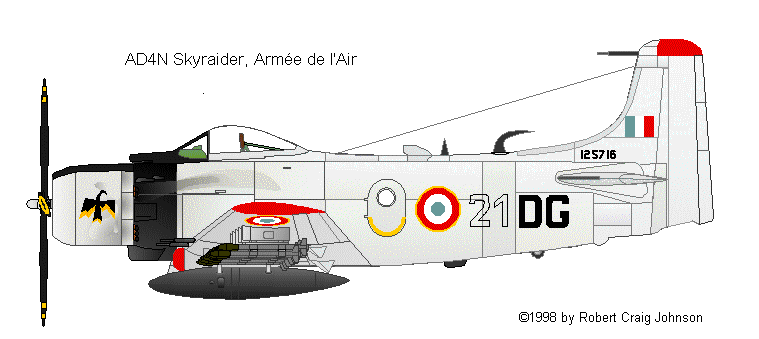
During the same period, France sought a heavier, piston-engined fighter-bomber to complement the
Fennecs. While the converted trainers had served well, none had proved entirely capable of replacing
the long-since retired F-47 Thunderbolts. While WW2 fighters were, of course, all but unobtainable
at this late date, fairly large quantities of piston-engined US Navy attack aircraft were just becoming
available. As jet types entered service, the Navy began to send the older marks of Douglas Skyraider to
the Davis-Monthan boneyard. Among these were a large number of 2-seat, AD4N night-attack bombers
retired at the end of the Korean War. The Armée de l'Air ordered 113 in 1956 and deliveries
commenced in 1958. The Skyraiders were stripped of their specialized equipment and operated as
conventional, daylight close-support aircraft. Like the Fennecs, the Skyraiders had only a short
career in Algeria. But they nonetheless proved to be the most successful of all the ad hoc COIN airplanes
deployed by the French. While the Fennecs, Tomcats, and Invaders were rapidly sold off at the end of the
Algerian War, AD4Ns continued in active service until the late 1970s. They were heavily involved in
the civil war in Chad, at first with the Armée de l'Air, and later with a nominally independent
local air force staffed by French mercenaries. The aircraft also operated under the French flag in
Djibouti and on the island of Madagascar. When France at last relinquished the Skyraiders ca. 1970, it
passed the survivors on to client states, including Gabon and Cambodia (several aircraft from Gabon
and Chad have been recovered recently by French warbird enthusiasts and entered on the French civil
register).
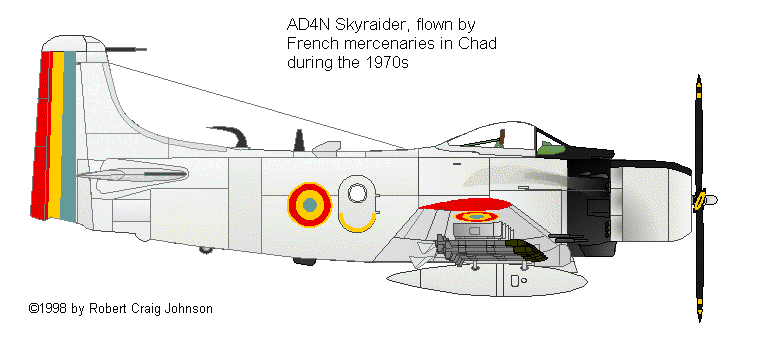
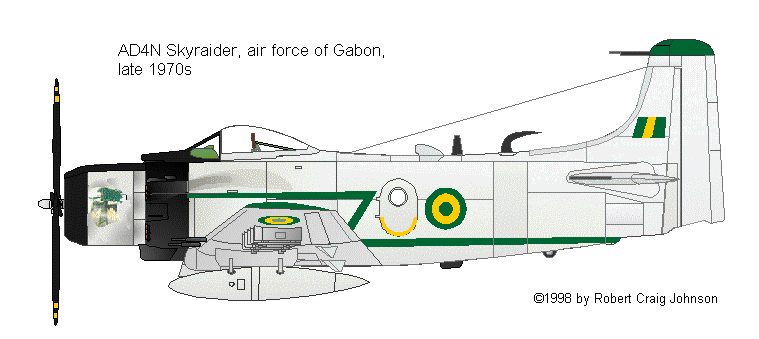
Transport presented fewer problems than close support, and conventional aircraft, such as the
venerable C-47 and the twin-boom Nord N2501 Noratlas, generally sufficed for most purposes. Nevertheless,
the French services quickly saw a need for an aircraft that was smaller than its smallest transport type
and capable of STOL performance, yet larger than the STOL grasshopper/AOP types then available.
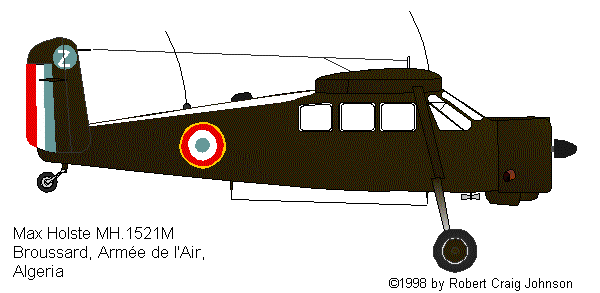 In the
early 1950s, the Max Holste firm (later Reims Aviation) developed its commercially unsuccessful
design for a light observation aircraft into a six-seat airplane able to combine the roles of observation
platform, casualty evacuation aircraft, and commando transport. The MH-1521M Broussard proved an
enormous success for the small Holste company. Between 1953 and 1959, 362 were built for the Armée de
l'Air and, more importantly, for the Army's ALAT. With its 45-ft wingspan, twin tails,
and 450-hp Pratt & Whitney R-985 piston engine, the Broussard could take off in 200 yds. Yet it
had a 700-mile range. The aircraft served with ALAT long after the Algerian war, and many were
subsequently passed on to former colonies or to Portugal, then locked in its own colonial wars further
south in Africa.
In the
early 1950s, the Max Holste firm (later Reims Aviation) developed its commercially unsuccessful
design for a light observation aircraft into a six-seat airplane able to combine the roles of observation
platform, casualty evacuation aircraft, and commando transport. The MH-1521M Broussard proved an
enormous success for the small Holste company. Between 1953 and 1959, 362 were built for the Armée de
l'Air and, more importantly, for the Army's ALAT. With its 45-ft wingspan, twin tails,
and 450-hp Pratt & Whitney R-985 piston engine, the Broussard could take off in 200 yds. Yet it
had a 700-mile range. The aircraft served with ALAT long after the Algerian war, and many were
subsequently passed on to former colonies or to Portugal, then locked in its own colonial wars further
south in Africa.
Imaginative as France's use of fixed wing strike and transport aircraft was, the most lasting innovation
to come out of French experience in Algeria was the heavy reliance placed on the helicopter. France made
aggressive use of helicopters in Algeria, both as troop transports and gunships.
In Indochina, a small number of Hiller H-23s and Sikorsky H-19s were available for casualty evacuation.
The technology of the time did not allow for much more. But by the time war broke out in French North
Africa, relatively large, powerful helicopters were available in quantity. Piasecki/Vertol H-21
and Sud-built Sikorski H-34 helicopters rapidly displaced fixed-wing aircraft for the transport of
paras and quick-reaction commando teams. The helicopter was fast, so guerillas had less chance
to fade away into the hills after an attack. They were immune to the ambushes and roadblocks that
constantly frustrated road convoys. By 1960, even large infantry operations were mounted by heliborne
troops.
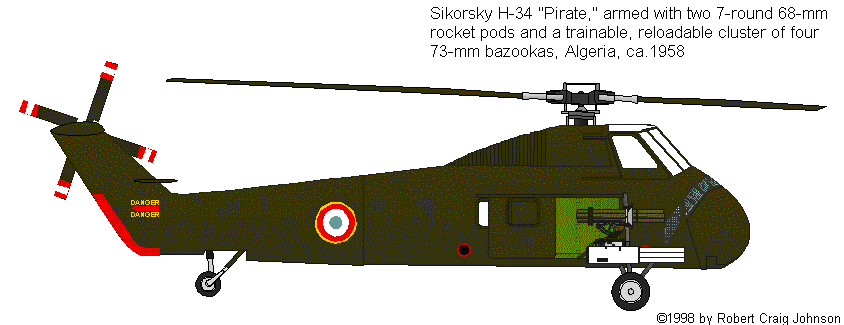
It was soon found, however, that helicopters were highly vulnerable during the initial, assault
landing phase of an airborne operation. Fixed wing aircraft like the AD4N helped, of course, but a
disciplined machine-gun team could often sit out a bombardment to get at the troop carriers following
them. The French therefore began to arm their helicopters. In 1955, French field commanders placed
infantry machine gunners in the stretcher panniers of their Bell 47 casualty evacuation helicopters. The
ad hoc gunships could outflank guerillas dug in on otherwise inaccessible ridges. But they were clearly
not ideal. In 1956, the French Air Force experimented with arming the H-19, then being superceded in the
transport by the more capable H-21 and H-34. In the rush to provide heavier fire than the Bell 47 had,
things were taken to a ridiculous extreme. The hapless H-19 was given a 20-mm cannon two rocket
launchers fixed to fire ahead, plus a 20-mm cannon, two 12.7-mm machine guns, and a 7.5-mm light
machine gun firing from the cabin windows. The guns and ammunition weighed more than the aircraft
could lift. While more lightly armed H-19s were used in action, they were still too liht and
low-powered for the gunship role. Some H-21s were armed with batteries of forward-firing rockets and
machine guns and some even had racks for quite heavy bombloads. But, excellent though they were as
load-lifters, they lacked the maneuverability and performance needed for offensive action. Most received
a door-mounted 12.7- or 20-mm gun for self defense only. The H-34 proved the best gunship of the bunch.
Standard armament comprised a light-weight, relatively low-recoil 20-mm cannon, the German-designed MG.151,
firing from the cabin door, two 12.7-mm machine guns firing from the cabin windows to port, and batteries of
37- or 68-mm rockets. Reloadable, quadruple mountings for 73-mm bazookas and additional fixed, forward-
firing guns were also tried.
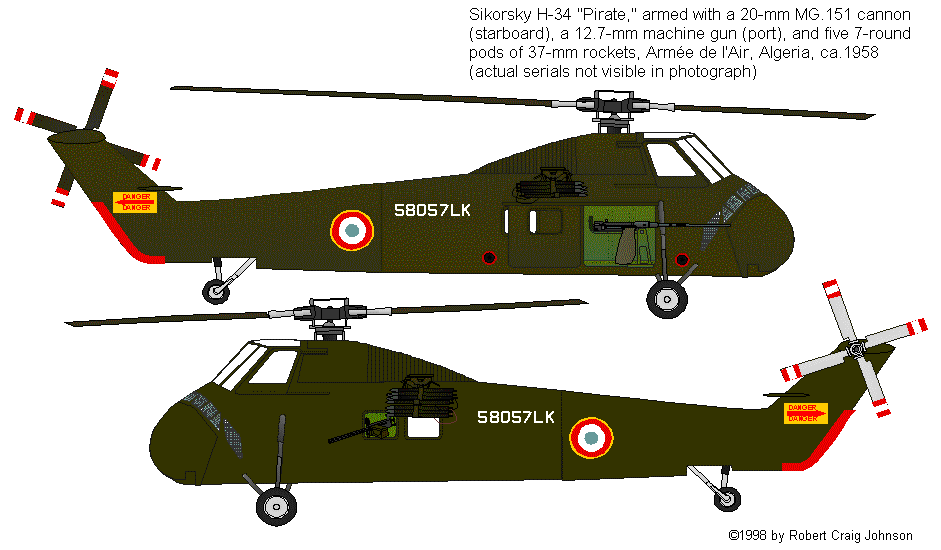
These "Pirates," as the gunships were known, often provided the most responsive and effective air support
for troops in the field. Heavy, fixed-wing aircraft, such as the B-26s and Skyraiders, were centrally
controlled and organized, as corps-level Groupements Aériens Tactiques or GATACs. These organizations
were designed for planned, set-piece operations and could not react quickly in a fluid situation. Their
bases were often far from the fighting—three GATACs covered the whole country from central bases at Oran,
Algiers, and Constantine. The T-6s, SIPAs, and Fennecs were organized into forward air commands and
dispersed across more of the country. But even this often failed to provide the near-immediate support
demanded by troops in contact with the elusive enemy. Since helicopters were often on the scene, with weapons
leftover after the landing zone had been cleared, ground commanders began to call on them for general fire
support. The results achieved eventually led both the air force and ALAT to regularize this field-expedient.
The basic helicopter unit, the Détachment d'Intervention Héliportée (DIH) became, in effect, the
organic air force of airborne infantry task force. Bell 47s or Alouette IIs performed reconnaissance and
command-and-control duties, while H-21s or H-34s transported the troops, and H-34 Pirates
provided the some or all of the routine fire support for the operation. This distinction between air-force
and army air-service roles would later be adopted in its entirety by the United States.
The light, guided missile even gave the helicopter a firepower advantage over fixed-wing aircraft in
some situations. During the Algerian war, the Nord SS.11 wire-guided antitank missile entered service
with the French infantry in Europe. Aviators quickly recognized the potential value of these weapons
in guerilla fighting. The missiles were first used against guerillas who had holed up in heavily
fortified mountain caves. T-6s and B-26s had been unable to drive the defenders from their positions
with the usual rockets and napalm. So a special unit, GOM.86, was formed to try the new AS.11 version of the
missile. Four were mounted under the wings of an MD-311 light transport and fired against the caves.
While the strikes were very successful, it could hardly have been easy to control these first-generation
missiles from a moving airplane in the hot, bumpy air over a desert mountain range. A hovering helicopter
had obvious advantages in this situation. French makers were now offering powerful, turbine-engined
helicopters that ccould easily handle the missiles and their sighting equipment, even at altitude in the
desert. Sud-Aviation Alouette IIs and IIIs could carry four missiles each, the latter often operating in
mixed formations with gun-armed Alouette IIIs, which could carry a 20-mm MG.151 cannon on a mounting
in the port cabin door.
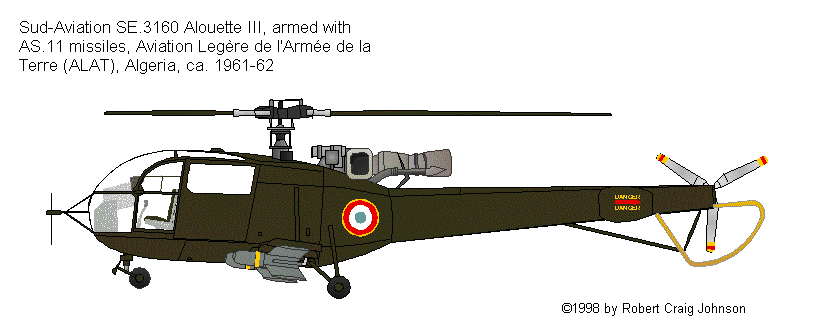
As the Algerian war drew towards its tumultuous close in the early 1960s, France at last had
at clear idea of the characteristics that they needed in a COIN air force. Two tuboprop-powered
fixed-wing types were needed, a light, single-engined observation/strike type and a heavier,
twin-engined light bomber and liason/transport aircraft. While the ad-hoc helicopter gunships had
served well, a dedicated type was wanted.
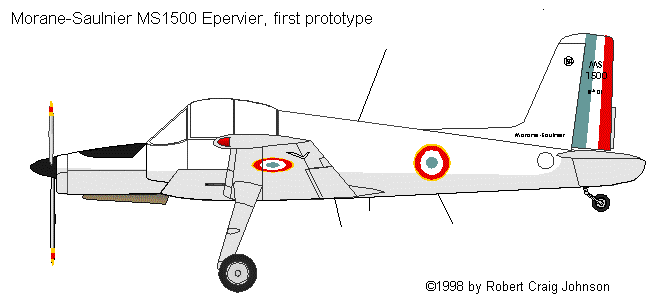 A leading contender for the first requirement was also one of the last products of the pioneering
Morane-Saulnier firm. The MS.1500 Epervier ("Sparrowhawk") was a two-seat, low-wing airplane
with a rugged, fixed landing gear, and a bulbous canopy. The cockpit was placed well forward, ahead
of the wing, for optimum visibility. Four 7.5-mm machine guns were mounted in the wings and light
ordnance loads, including AS.11 missiles, could be caried under the wings. Light armor protected the crew
from ground fire. The first prototype (shown in the accompanying illustration) first flew with a
400-shp Turboméca Marcadau turboprop engine, but was later re-engined with the planned
production powerplant, the substantially more powerful, 805-shp Bastan. The Epervier
could reach a modest top speed of 199 mph at 5000 ft (206 mph at 10,000 ft). Initial climb was about
1800 ft/min. Normal range was 528 miles (808 miles max). The airplane weighed 3505 lbs empty and 5512 lbs
loaded (max. 6062 lbs). It spanned 42 ft 10 in was 34 ft 8.5 in long, and had a wing area of 258 sq ft.
A leading contender for the first requirement was also one of the last products of the pioneering
Morane-Saulnier firm. The MS.1500 Epervier ("Sparrowhawk") was a two-seat, low-wing airplane
with a rugged, fixed landing gear, and a bulbous canopy. The cockpit was placed well forward, ahead
of the wing, for optimum visibility. Four 7.5-mm machine guns were mounted in the wings and light
ordnance loads, including AS.11 missiles, could be caried under the wings. Light armor protected the crew
from ground fire. The first prototype (shown in the accompanying illustration) first flew with a
400-shp Turboméca Marcadau turboprop engine, but was later re-engined with the planned
production powerplant, the substantially more powerful, 805-shp Bastan. The Epervier
could reach a modest top speed of 199 mph at 5000 ft (206 mph at 10,000 ft). Initial climb was about
1800 ft/min. Normal range was 528 miles (808 miles max). The airplane weighed 3505 lbs empty and 5512 lbs
loaded (max. 6062 lbs). It spanned 42 ft 10 in was 34 ft 8.5 in long, and had a wing area of 258 sq ft.

The Sud-Aviation SE.117 Voltigeur ("Skirmisher") was, with the Dassault Spirale, a
competitor for the twin-engined requirement. The SE.117 was a 2- to 6-seat multirole aircraft armed with
two 30-mm DEFA cannon in semi-external, fuselage pods. Underwing loads could include one 1000-lb and
two 500-lb bombs, 24 rockets, or four AS.11 missiles. The pilot and co-pilot/observer sat side-by-side
in an extensively glazed nose compartment, well ahead of the low-mounted wing. To facilitate
air-to-ground operations at low level, large, perforated dive brakes were fitted on the rear fuselage.
The first prototype, the SE.116, flew in December 1958 powered by a pair of 800-hp, Wright R-1300
Cyclone piston engines. Production versions would have had Bastan turboprops. The estimated
maximum speed for the Voltigeur was 277 mph (236 mph cruising). Initial climb rate was to be 2677
ft/min and ceiling was 30,800 ft. Range topped 1100 miles and endurance was more than 5 hours.
The airplane spanned 59 ft, was 40 ft 6 in long, and had a wing area of 443.5 sq ft.
Despite considerable interest and some off-shore procurement funding from the United States, the
Voltigeur and the Epervier never saw production. The Algerian war was over before the
intended turboprop engines became available, and France's greatly reduced postwar COIN needs
were more than met by the many remnaining AD4N Skyraiders. A 67%-identical, commercial transport
derived from the Voltigeur, the SE.118 Diplomate, also failed to attract orders.
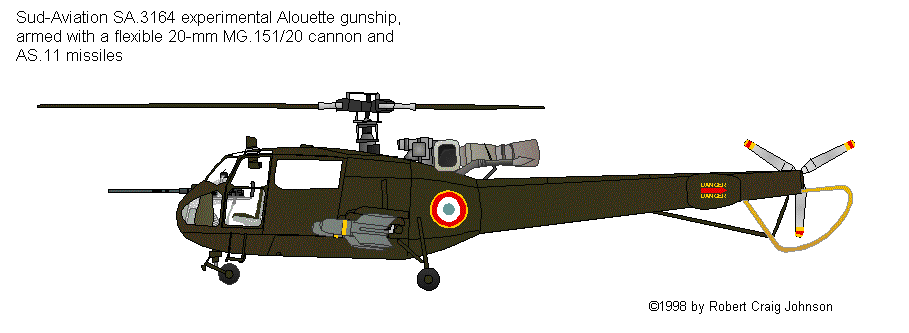
France's first attempt at a specialized, armed helicopter fared no better than these fixed-wing
contemporaries. The still limited power that could be handled by the transmissions of the time made
the helicopter gunship a particularly difficult proposition in the early 1960s. Any increase in
weaponry or protection beyond that achieved with the ad-hoc aircraft in Algeria imposed a severe
performance penalty. As the Americans discovered in Vietnam, a loaded, first-generation gunship was
hard-pressed to to keep station with lighter troop-carrier helicopters. France's first attempt at
such an aircraft, the Sud-Aviation SA.3164, was essentially an Allouete III with a flexible mounting
for a 20-mm MG.151 cannon in the nose and a periscopic sight for AS.11 missiles in the roof. The SA.3164
used the same engine and transmission and carried its rockets and AS.11s on the same type of rack as
the standard Alouette. Tests showed that, both cannon and missiles mounted, the dedicated gunship's
performance was too poor for serious service use. With only the gun or the missiles, it offered no
advantage over the armed Alouette III.
And what of the innovative tactical and strategic thinking that gave rise to these interesting if
ill-fated aircraft? It too had a singularly unhappy history. The counterinsurgency doctrine that came
out of Indochina proved unable to stem the nationalist tide and incapable of salvaging French interests
in the region. Worse, it instilled a penchant for secrecy and an antidemocratic, militarist spirit
in its adherents reminiscent of the fruit of that other unsuccessful piece of 20th-century military
brilliance, the stormtrooper offensives of 1918. The idea that political will was the
key to victory gave the soldiers of the 1960s and '70s an easy scapegoat, as it had done in 1919. Armies
never lost to superior troops, numbers, or materiel. Rather, they were "stabbed in the back" by spineless
politicians and milksop civilians who lacked the will to win. The results seem predictable enough in
hindsight. To the tough para officers of 1960, civilian laws, values, and morality were merely
the contemptible, false front behind which the real actors in history, themselves, struggled
against an evil reality that civilians could not bring themselves to face. In Algeria, paras
and Legionaires considered themselves beyond law or custom. They engaged in a calculated, carefully
rationalized, even moralized reign of terror. They became torturers and terrorists and claimed to be
the better for it. They defied government orders and policies on the grounds that they themselves
represented a higher law. This attitude reached its logical extreme in 1962. In righteous
indignation at DeGaulle's expressed preference for a negotiated peace, the élite, counterinsurgency
troops mounted an abortive coup against the French government. When this was crushed by
loyal troops from the conventional units of the French army, survivors formed a terrorist group, the
OAS, and dedicated themselves to trying to kill President DeGaulle. The apostles of counterinsurgency
thus turned out to be the only truly dangerous subversives to threaten a Western governement during the
nuclear age.
Next page
Return to Table of Contents
© 1998 by Robert Craig Johnson.
 All this staff-level cerebration
resulted in a technical and political tour de force, the counter-insurgency or
limited-war doctrine that would in large part shape international relations for the next four
decades. Like many earlier French efforts, it was self-consciously revolutionary, extreme, idealistic,
and short on the gritty details that often make or break real campaigns. While the French theorists
conceived a whole range of practical, tactical measures, some of which form the main subject of
this article, they did not place much hope in the mechanics of a material struggle that they all
but conceded to the Asian and African hoardes. Instead, they recast war as an ideological, moral
struggle, a crusade that would be won by the spiritually stronger society. When they tried to define
the best way of using France's limited resources in the kind of war she now had to fight, they stressed
the esprit de corps of small, élite units, the resourcefulness and self-sacrifice of the
wholly committed individual, the professionalism and mystical, sacred honor of the army, and the
supposedly world-historical, civilizing mission of France. Combined operations, mobility,
intelligence, and psycho-political warfare would be important. But these tactical expedients were
only ways of winning time. While France's paladins kept the enemy at bay, the real battle—the battle for
hearts and minds—would be fought elsewhere, at home and, above all, in the treasury of the post-war
West, the United States.
All this staff-level cerebration
resulted in a technical and political tour de force, the counter-insurgency or
limited-war doctrine that would in large part shape international relations for the next four
decades. Like many earlier French efforts, it was self-consciously revolutionary, extreme, idealistic,
and short on the gritty details that often make or break real campaigns. While the French theorists
conceived a whole range of practical, tactical measures, some of which form the main subject of
this article, they did not place much hope in the mechanics of a material struggle that they all
but conceded to the Asian and African hoardes. Instead, they recast war as an ideological, moral
struggle, a crusade that would be won by the spiritually stronger society. When they tried to define
the best way of using France's limited resources in the kind of war she now had to fight, they stressed
the esprit de corps of small, élite units, the resourcefulness and self-sacrifice of the
wholly committed individual, the professionalism and mystical, sacred honor of the army, and the
supposedly world-historical, civilizing mission of France. Combined operations, mobility,
intelligence, and psycho-political warfare would be important. But these tactical expedients were
only ways of winning time. While France's paladins kept the enemy at bay, the real battle—the battle for
hearts and minds—would be fought elsewhere, at home and, above all, in the treasury of the post-war
West, the United States. 
 Guerillas could not concentrate rapidly enough to overrun outposts before reinforcements arrived. Nor
could they easily disperse or evade pursuit. Since route security was no longer necessary, far fewer
troops were necessary. Major operations could be mounted by relative handfuls of professional light
infantry—Foreign Legionaires, paras and marine commandos. It was even hoped that, in the absence
of aerial opposition, modern combat aircraft could give the airborne force the firepower that light
infantry had lacked in the past. With napalm, rockets, fragmentation bombs, and machine guns, a few
pilots could, perhaps, do most of the killing from the safety of the air, before the infantry arrived.
Survivors could then be kept constantly on the run and never allowed to rest or regroup. Most
importantly of all, air power could greatly reduce the political vulnerability of colonial operations.
By reducing the need for large numbers of French troops, air strikes minimized casualties and
obviated much of the need for unpopular, large-scale conscription.
Guerillas could not concentrate rapidly enough to overrun outposts before reinforcements arrived. Nor
could they easily disperse or evade pursuit. Since route security was no longer necessary, far fewer
troops were necessary. Major operations could be mounted by relative handfuls of professional light
infantry—Foreign Legionaires, paras and marine commandos. It was even hoped that, in the absence
of aerial opposition, modern combat aircraft could give the airborne force the firepower that light
infantry had lacked in the past. With napalm, rockets, fragmentation bombs, and machine guns, a few
pilots could, perhaps, do most of the killing from the safety of the air, before the infantry arrived.
Survivors could then be kept constantly on the run and never allowed to rest or regroup. Most
importantly of all, air power could greatly reduce the political vulnerability of colonial operations.
By reducing the need for large numbers of French troops, air strikes minimized casualties and
obviated much of the need for unpopular, large-scale conscription. 
 In 1948 and '49, the rapid collapse of the Kuomintang regime in China and the apparently cordial
relations between the Viet Minh and Mao's Communist party caused the US to relent and allow
France to deploy some of its American equipment in Southeast Asia. Fifty Bell P-63C Kingcobras were
hurriedly despatched from Europe. They proved well suited to the climate and the prevailing type of
operations. Their range was better than the Spitfires, and were highly resistant to the ever increasing
volume of groundfire that French pilots faced over Viet Minh-dominated areas. The lifting of the
ban on US warplanes also let the French Aéronavale take a more active role in the conflict. The
light carrier Arromanches took up station in the gulf of Tonkin and used its SB2C Helldivers,
F6F-5 Hellcats, and, eventually, F4U-7 Corsairs to good effect during the remainder of the campaign.
Douglas SBD-5 Dauntless dive bombers and Consolidated PB4Y-2 Privateers operated from shore bases. The
Long time on station and heavy bombloads made the Privateers particularly useful. They were often pressed
into service as flareships during night assaults on French positions.
In 1948 and '49, the rapid collapse of the Kuomintang regime in China and the apparently cordial
relations between the Viet Minh and Mao's Communist party caused the US to relent and allow
France to deploy some of its American equipment in Southeast Asia. Fifty Bell P-63C Kingcobras were
hurriedly despatched from Europe. They proved well suited to the climate and the prevailing type of
operations. Their range was better than the Spitfires, and were highly resistant to the ever increasing
volume of groundfire that French pilots faced over Viet Minh-dominated areas. The lifting of the
ban on US warplanes also let the French Aéronavale take a more active role in the conflict. The
light carrier Arromanches took up station in the gulf of Tonkin and used its SB2C Helldivers,
F6F-5 Hellcats, and, eventually, F4U-7 Corsairs to good effect during the remainder of the campaign.
Douglas SBD-5 Dauntless dive bombers and Consolidated PB4Y-2 Privateers operated from shore bases. The
Long time on station and heavy bombloads made the Privateers particularly useful. They were often pressed
into service as flareships during night assaults on French positions. Ex-USAF C-47 transports soon replaced the inadequate Toucan in the transport role. The
Aéronavale received additional Hellcats in lieu of Corsairs (though the specially built F4U-7 and
some surplus AU-1s were supplied later), while the Armée de l'Air got the Grumman F8F-1 Bearcat,
a type relegated to Navy Reserve and National Guard units in the US. A further five RB-26C reconnaissance
airplanes and 16 B-26C bombers arrived in 1952. Armed with napalm, 500-lb demolition bombs, M1A1
fragmentation clusters, 5-in HVAR rockets, and .50-cal machineguns (up to fourteen on the B-26s, most
of which had the late-war, 6-gun wings and both turrets) or 20-mm cannon (many F8Fs and F6Fs and all
the Corsairs) the new strike aircraft were reasonably effective. But they were still too few, and the
single-engined types lacked the range and endurance that were increasingly necessary now that Viet Minh
were now concentrated in Laos and along the Chinese border (the mainstay of the fighter-bomber force,
the F8F, had, after all, been designed as a short-range, high-performance interceptor of Kamikazes).
Ex-USAF C-47 transports soon replaced the inadequate Toucan in the transport role. The
Aéronavale received additional Hellcats in lieu of Corsairs (though the specially built F4U-7 and
some surplus AU-1s were supplied later), while the Armée de l'Air got the Grumman F8F-1 Bearcat,
a type relegated to Navy Reserve and National Guard units in the US. A further five RB-26C reconnaissance
airplanes and 16 B-26C bombers arrived in 1952. Armed with napalm, 500-lb demolition bombs, M1A1
fragmentation clusters, 5-in HVAR rockets, and .50-cal machineguns (up to fourteen on the B-26s, most
of which had the late-war, 6-gun wings and both turrets) or 20-mm cannon (many F8Fs and F6Fs and all
the Corsairs) the new strike aircraft were reasonably effective. But they were still too few, and the
single-engined types lacked the range and endurance that were increasingly necessary now that Viet Minh
were now concentrated in Laos and along the Chinese border (the mainstay of the fighter-bomber force,
the F8F, had, after all, been designed as a short-range, high-performance interceptor of Kamikazes).

 But they proved woefully ineffective. They lacked endurance and proved hard to maintain in the sand and
dust of North Africa. Worse, they were too fast. It was all but impossible to spot and attack small
groups of guerillas from a fast jet. The Republic F-47D Thunderbolts of the advanced training units
proved more effective, but they were old and parts were all but impossible to obtain. Since there were
no propellor-driven replacement fighter-bombers available in 1955, local French commanders
began to arm light transports and trainers. Dassault MD.311 Flamants, Morane-Saulnier MS.500s, and
the SIPA S.111s and 211s were fitted with machine guns and 37-mm rockets. These airplanes were formed
into Escadrilles d'Aviation Legère d'Appui (EALA)—Light Tactical Aviation Squadrons—and used to
good effect. With an observer spotting targets from the rear seat, such an aircraft was roughly twice
as likely to spot a target as a conventional fighter-bomber and, given the relative unsophistication
of the adversary, its light armament (no more than four rockets or two machine guns for the
SIPAs and MS.500s) was not too great a handicap.
But they proved woefully ineffective. They lacked endurance and proved hard to maintain in the sand and
dust of North Africa. Worse, they were too fast. It was all but impossible to spot and attack small
groups of guerillas from a fast jet. The Republic F-47D Thunderbolts of the advanced training units
proved more effective, but they were old and parts were all but impossible to obtain. Since there were
no propellor-driven replacement fighter-bombers available in 1955, local French commanders
began to arm light transports and trainers. Dassault MD.311 Flamants, Morane-Saulnier MS.500s, and
the SIPA S.111s and 211s were fitted with machine guns and 37-mm rockets. These airplanes were formed
into Escadrilles d'Aviation Legère d'Appui (EALA)—Light Tactical Aviation Squadrons—and used to
good effect. With an observer spotting targets from the rear seat, such an aircraft was roughly twice
as likely to spot a target as a conventional fighter-bomber and, given the relative unsophistication
of the adversary, its light armament (no more than four rockets or two machine guns for the
SIPAs and MS.500s) was not too great a handicap. 




 However, a
private, California firm, Pacific Airmotive, was then offering a more powerful, civilianized T-28A
called the Nomad. In place of the 800-hp Wright R-1300 of the T-28A, the Nomad mounted a 1425-hp
Wright R1820-76A Cyclone salvaged from B-17G stocks. Performance was excellent, but there were few
civilian takers. France accordingly contracted with Pacific Airmotive for the design of a Nomad
variant fitted with armorplate, reinforced wings, and increased cockpit ventilation: the
T-28S Fennec ("Desert Fox"). Under the agreement, the California firm supplied design drawings,
engines, and airframes for shipment to France, where Sud-Aviation would perform the conversion and
install French equipment, armament, and sand filters. Fennecs were strenghtened to take four
underwing weapons pylons. The two inner pylons usually carried French-designed pods for twin
.50-cal (12.7-mm) machine guns. The outer pylons could carry shortened 440-lb bombs, 7- or 36-round
pods of 37- or 68-mm rockets, napalm, or single 105- or 120-mm rockets. By 1961, over 100 Fennecs were
operating with four EALAs in Algeria, with 50 more in reserve or final assembly. But their time in
service was brief.
However, a
private, California firm, Pacific Airmotive, was then offering a more powerful, civilianized T-28A
called the Nomad. In place of the 800-hp Wright R-1300 of the T-28A, the Nomad mounted a 1425-hp
Wright R1820-76A Cyclone salvaged from B-17G stocks. Performance was excellent, but there were few
civilian takers. France accordingly contracted with Pacific Airmotive for the design of a Nomad
variant fitted with armorplate, reinforced wings, and increased cockpit ventilation: the
T-28S Fennec ("Desert Fox"). Under the agreement, the California firm supplied design drawings,
engines, and airframes for shipment to France, where Sud-Aviation would perform the conversion and
install French equipment, armament, and sand filters. Fennecs were strenghtened to take four
underwing weapons pylons. The two inner pylons usually carried French-designed pods for twin
.50-cal (12.7-mm) machine guns. The outer pylons could carry shortened 440-lb bombs, 7- or 36-round
pods of 37- or 68-mm rockets, napalm, or single 105- or 120-mm rockets. By 1961, over 100 Fennecs were
operating with four EALAs in Algeria, with 50 more in reserve or final assembly. But their time in
service was brief.


 In the
early 1950s, the Max Holste firm (later Reims Aviation) developed its commercially unsuccessful
design for a light observation aircraft into a six-seat airplane able to combine the roles of observation
platform, casualty evacuation aircraft, and commando transport. The MH-1521M Broussard proved an
enormous success for the small Holste company. Between 1953 and 1959, 362 were built for the Armée de
l'Air and, more importantly, for the Army's ALAT. With its 45-ft wingspan, twin tails,
and 450-hp Pratt & Whitney R-985 piston engine, the Broussard could take off in 200 yds. Yet it
had a 700-mile range. The aircraft served with ALAT long after the Algerian war, and many were
subsequently passed on to former colonies or to Portugal, then locked in its own colonial wars further
south in Africa.
In the
early 1950s, the Max Holste firm (later Reims Aviation) developed its commercially unsuccessful
design for a light observation aircraft into a six-seat airplane able to combine the roles of observation
platform, casualty evacuation aircraft, and commando transport. The MH-1521M Broussard proved an
enormous success for the small Holste company. Between 1953 and 1959, 362 were built for the Armée de
l'Air and, more importantly, for the Army's ALAT. With its 45-ft wingspan, twin tails,
and 450-hp Pratt & Whitney R-985 piston engine, the Broussard could take off in 200 yds. Yet it
had a 700-mile range. The aircraft served with ALAT long after the Algerian war, and many were
subsequently passed on to former colonies or to Portugal, then locked in its own colonial wars further
south in Africa.


 A leading contender for the first requirement was also one of the last products of the pioneering
Morane-Saulnier firm. The MS.1500 Epervier ("Sparrowhawk") was a two-seat, low-wing airplane
with a rugged, fixed landing gear, and a bulbous canopy. The cockpit was placed well forward, ahead
of the wing, for optimum visibility. Four 7.5-mm machine guns were mounted in the wings and light
ordnance loads, including AS.11 missiles, could be caried under the wings. Light armor protected the crew
from ground fire. The first prototype (shown in the accompanying illustration) first flew with a
400-shp Turboméca Marcadau turboprop engine, but was later re-engined with the planned
production powerplant, the substantially more powerful, 805-shp Bastan. The Epervier
could reach a modest top speed of 199 mph at 5000 ft (206 mph at 10,000 ft). Initial climb was about
1800 ft/min. Normal range was 528 miles (808 miles max). The airplane weighed 3505 lbs empty and 5512 lbs
loaded (max. 6062 lbs). It spanned 42 ft 10 in was 34 ft 8.5 in long, and had a wing area of 258 sq ft.
A leading contender for the first requirement was also one of the last products of the pioneering
Morane-Saulnier firm. The MS.1500 Epervier ("Sparrowhawk") was a two-seat, low-wing airplane
with a rugged, fixed landing gear, and a bulbous canopy. The cockpit was placed well forward, ahead
of the wing, for optimum visibility. Four 7.5-mm machine guns were mounted in the wings and light
ordnance loads, including AS.11 missiles, could be caried under the wings. Light armor protected the crew
from ground fire. The first prototype (shown in the accompanying illustration) first flew with a
400-shp Turboméca Marcadau turboprop engine, but was later re-engined with the planned
production powerplant, the substantially more powerful, 805-shp Bastan. The Epervier
could reach a modest top speed of 199 mph at 5000 ft (206 mph at 10,000 ft). Initial climb was about
1800 ft/min. Normal range was 528 miles (808 miles max). The airplane weighed 3505 lbs empty and 5512 lbs
loaded (max. 6062 lbs). It spanned 42 ft 10 in was 34 ft 8.5 in long, and had a wing area of 258 sq ft.

